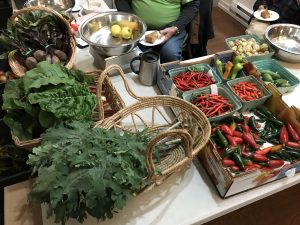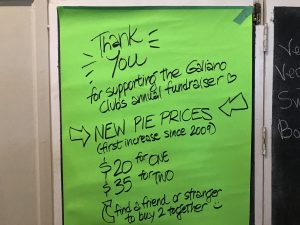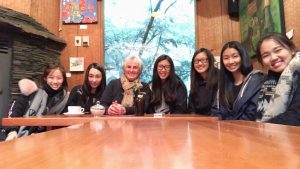What
As a group, none of the assignments we have done have turned out to be perfect, but we are thankful that none of the experiences were bad enough to make us turn our backs on improving. The experience that taught us the most was the proposal. In the proposal and final report, the problem we encountered was trying to solve a food security and food justice issue that our project was not related to. We tried to make the connection that culturally appropriate foods were important for food justice (which is true), but we lacked a connection from culturally appropriate foods to our Galiano Island population. Our examples included eating nettles and canning, which were not distinct cultural practices. Furthermore, our population consisted of mostly Caucasian seniors and there was not very much cultural diversity on the island, to begin with in order to recommend culturally appropriate foods that they didn’t already eat. Their food culture is not distinct from other populations (as far as we can tell from their menu items). Our knowledge at the time when we wrote the proposal, was limited. We thought there was more we could do to solve community food insecurity on the island. However, we were not asked to measure the general health of the population and tackle the issue of community food insecurity. Our only job was to provide a nutritional assessment of the Food Program menu items. Therefore, we did not have a convincing story of how our project would influence community food security or food justice. As we learned in class last week, the course had been altered to allow us not to tackle food insecurity. Tackling food insecurity is something students could do next year instead.
Furthermore, we found on our time on the island that there was a close community on Galiano that we don’t usually see in the city. Even though neighbors didn’t live close to each other, everyone still knew each other. The dynamics of this community are explained further in the next section.

So What
Only one of us had visited Galiano Island before, so for most of us, it was the first time. We were unsure of what to expect. We did have an itinerary, so we had an idea of the schedule and the things we were going to take part in the island, but we did not know how the community on the island would react towards us. All of us were very excited to do this trip, so that made us create high expectations for it, but also because we went not really knowing what to expect in terms of what we would find, I think we approached the trip and the entire experience with an open-minded mentality. This allowed us to come to some realizations like the ones mentioned later in this post.
In our time on the island, we discovered that community had a different definition on the island than it does in UBC or even Vancouver. Due to the small population on Galiano, everyone seemed to know each other and the islanders were resourceful enough to lend each other items whenever someone needed it. Since the ferries don’t come very often to the island (most days it comes twice a day, once in the morning and once in the evening), it would have been difficult to go to other islands to buy what they needed. In this situation, being resourceful and having connections on the island was vital for living on the island. Community in our neighborhoods is not like this at all. We don’t even know our neighbors sometimes even though we’ve lived here for a long time. We thought that island life would be lonely and boring because there are not very many people and not a lot of activities to do, but that wasn’t the case at all. In fact, some of us think that our lives in the city are a lot more lonely than the community of Galiano. Life is more fast-paced in the city and people don’t have time to look out for each other the way that the Galiano community does. For example, at Galiano, everyone will look for a person if that person hasn’t come home overnight and is missing. At the marketplace, there would be pie sales if you purchase two pies and it would have signs asking you to buy with a stranger. We believe that this closeness and barrier-less connection between people on the island is something we are missing in the bigger cities.

Now What
As mentioned above, one of the difficulties we faced was attempting to solve food insecurity and food justice. We later realized that that was not what was asked of us. As a result of this missing information, our proposal mark was affected significantly. What was asked by our community partner was to provide a nutritional assessment for the menu items from the Galiano Food Program.This was something much more achievable in terms of our knowledge, time and resources. We realized that if we were to tackle such a huge issue such as food insecurity, it would take a lot more resources than what we currently have to achieve that goal. In addition, we need to consider what community means in different situations to different people. We need to understand the community bonds, and what they are when we are going into any kind of food systems work and what kind of work they do. Therefore, rather than trying to solve this huge issue on our own, we can do what we currently can and provide a good foundation for the next group to build from where we left off. In order to provide a good foundation, we can use what that Galiano Club has already built and what they already know and expand from there. By doing this, it will allow the next group to gain a better understanding of our project and help guide them in the right direction. When writing our final report, we can take what the Galiano Club is already doing to address community food insecurity and talk about what our project has done to enhance/help their efforts.
Utilizing the resource and knowledge of what the Club already has to help them takes us back to what we learned at the beginning of the semester. After this realization, and learning more about our project and community partner, we now understand the meaning of the term asset-based community development. For example, at the beginning of the semester, we realized that one of the best approaches one can take is to tackle a large issue such as food insecurity. We would then start off with what has been working for the Galiano Club and from there, we build off of the small foundation that has been set for us. In doing so, we will be able to provide the help that the Galiano Club is expecting from us as well as taking a step closer to solving the bigger issue.
In terms of what we learned on the island, the sense of community on the island is something we should all try to incorporate into our own lives. We can try to recreate this strong bond with everyone in our neighborhoods. A way to do this could be introducing ourselves to our neighbors, hosting neighborhood events, and caring for each other in various ways such as looking after each other’s’ houses and collecting their mail while they’re on vacation. Starting with something small within our own community could potentially turn into a tradition for the years to come. With this, the new neighbors that enter your community will be able to sense the feeling of belonging and participate in these events.
